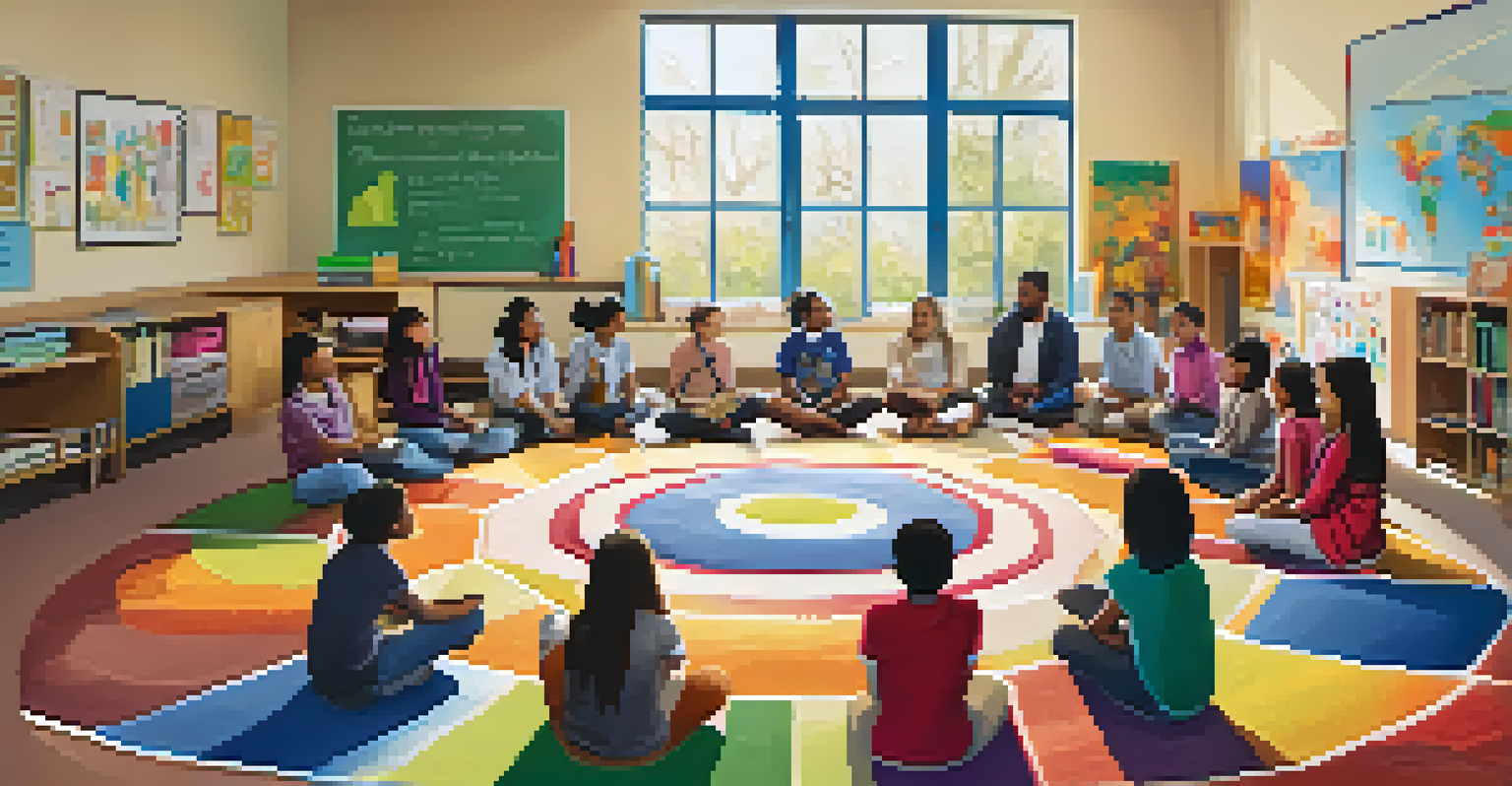Project-Based Learning and Social Emotional Learning

Understanding Project-Based Learning (PBL)
Project-Based Learning, or PBL, is an educational approach that emphasizes hands-on, real-world projects. Instead of traditional lectures, students engage in complex questions or challenges that require critical thinking and collaboration. This method not only makes learning more interesting but also helps students retain information longer as they apply their knowledge to practical situations.
The best way to predict the future is to create it.
An example of PBL might involve students working together on a community garden project, where they must research plants, design the layout, and consider environmental factors. This collaborative effort encourages them to communicate effectively and share responsibilities, fostering teamwork. The focus on a tangible outcome makes learning more relevant and engaging.
Moreover, PBL encourages students to take ownership of their learning. By setting their own goals and determining how to achieve them, they develop key skills such as problem-solving and self-management. This autonomy is essential for cultivating a sense of responsibility and motivation among learners.
Defining Social Emotional Learning (SEL)
Social Emotional Learning, or SEL, focuses on the development of skills necessary for emotional intelligence and interpersonal relationships. It encompasses five key areas: self-awareness, self-management, social awareness, relationship skills, and responsible decision-making. These competencies are crucial for students to navigate their social environments effectively.

For instance, a student with strong self-awareness can recognize their emotions and understand how they impact their behavior. This awareness enables them to manage their reactions and interact positively with peers. When students are equipped with SEL skills, they are better prepared for both academic challenges and personal interactions.
PBL Engages Through Real Projects
Project-Based Learning immerses students in hands-on projects that enhance engagement and knowledge retention.
Implementing SEL in schools can lead to improved classroom behavior and academic performance. By fostering a supportive learning environment, educators can help students develop resilience and empathy. This holistic approach to education acknowledges that emotional and social skills are as important as academic knowledge.
The Connection Between PBL and SEL
At first glance, Project-Based Learning and Social Emotional Learning may seem like separate entities, but they complement each other beautifully. PBL creates a collaborative environment where students must rely on each other, which naturally fosters SEL skills. Through teamwork and joint problem-solving, students learn to communicate effectively, resolve conflicts, and appreciate diverse perspectives.
Education is not the filling of a pail, but the lighting of a fire.
For example, while working on a project, students may face disagreements about how to proceed. This scenario provides a perfect opportunity for them to practice social awareness and relationship skills as they navigate these challenges together. Such experiences are critical for developing empathy and understanding among classmates.
Additionally, the reflective aspect of PBL allows students to evaluate not just their project outcomes, but also their personal growth in social-emotional areas. By assessing their participation and contributions, they can identify strengths and areas for improvement, leading to greater self-management and resilience.
Benefits of Integrating PBL and SEL
Integrating Project-Based Learning with Social Emotional Learning offers numerous benefits for students. It promotes a more engaging learning environment where students feel connected to their peers and the material. This connection enhances motivation and leads to deeper learning experiences.
Moreover, students develop essential life skills that extend beyond the classroom. Skills like teamwork, communication, and empathy are invaluable in both personal and professional settings. By incorporating these elements into education, we prepare students not just for exams, but for real-life challenges.
SEL Builds Emotional Intelligence
Social Emotional Learning equips students with vital interpersonal skills essential for academic and personal success.
Finally, the integration supports positive school culture. When students feel valued and understood, they are more likely to contribute positively to their learning community. This sense of belonging is crucial for fostering an environment where all students can thrive.
Implementing PBL with SEL in the Classroom
To effectively implement Project-Based Learning alongside Social Emotional Learning, educators need to plan thoughtfully. It starts with selecting projects that encourage collaboration and require students to engage with their emotions and the emotions of others. Choosing topics that resonate with students' interests can spark enthusiasm and commitment.
Incorporating regular reflection sessions during projects can help students think critically about their social-emotional skills. For instance, after completing a project, teachers might facilitate discussions about what went well, what challenges arose, and how they felt throughout the process. This reflection not only solidifies learning but also fosters a growth mindset.
Lastly, teachers can model SEL competencies by demonstrating effective communication and conflict resolution strategies. By showing students how to navigate social interactions, educators create a safe space where students feel comfortable practicing these skills as they work together.
Challenges in Merging PBL and SEL
While the integration of Project-Based Learning and Social Emotional Learning is beneficial, it does come with its challenges. One significant hurdle is the need for teacher training; educators must be well-versed in both methodologies to implement them effectively. Without proper preparation, the potential benefits may not be fully realized.
Another challenge is the varying levels of social-emotional skills among students. Some students may struggle with collaboration and communication, making teamwork difficult. Teachers need to provide tailored support and intervention strategies to ensure all students can participate meaningfully.
PBL and SEL Enhance Learning Together
Integrating PBL and SEL creates a collaborative environment that fosters critical life skills like teamwork and empathy.
Lastly, time constraints may limit the ability to fully explore projects or focus on SEL. Balancing curriculum requirements with the desired depth of learning can be tricky. However, with strategic planning and prioritization, educators can create a harmonious blend of PBL and SEL that enriches the educational experience.
Conclusion: The Future of Education with PBL and SEL
As we look to the future of education, the integration of Project-Based Learning and Social Emotional Learning will play a crucial role in shaping well-rounded individuals. By combining these approaches, we prepare students not just for academic success, but for life beyond the classroom. They emerge as critical thinkers, effective communicators, and empathetic leaders.
Moreover, this integration fosters a positive learning environment where students feel safe to express themselves and collaborate with others. When students are emotionally supported, their engagement and retention rates soar, leading to a more dynamic and productive classroom experience.

In essence, embracing both PBL and SEL equips students with the tools they need to thrive in an increasingly complex world. By prioritizing both academic and emotional growth, we are paving the way for a generation of learners who are not only knowledgeable but also compassionate and resilient.